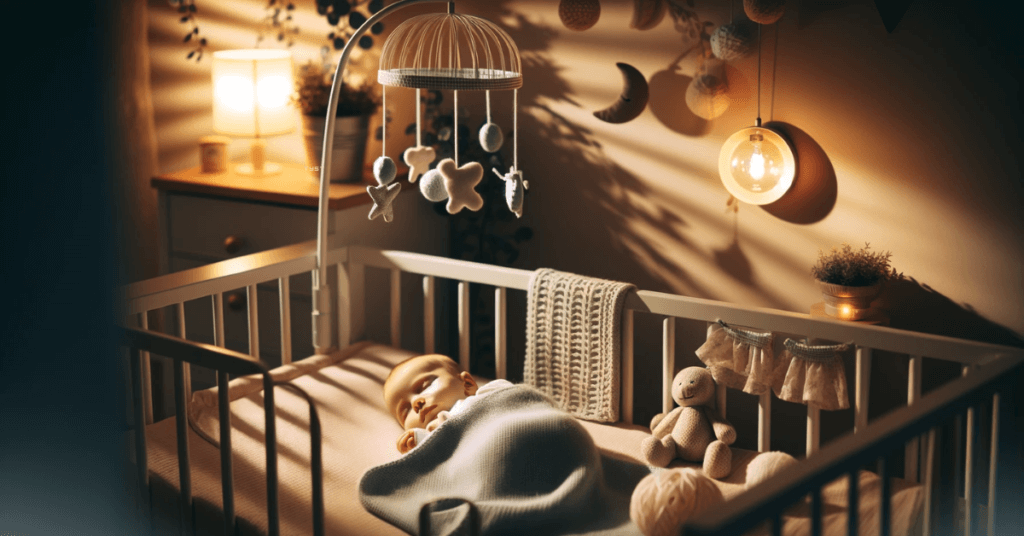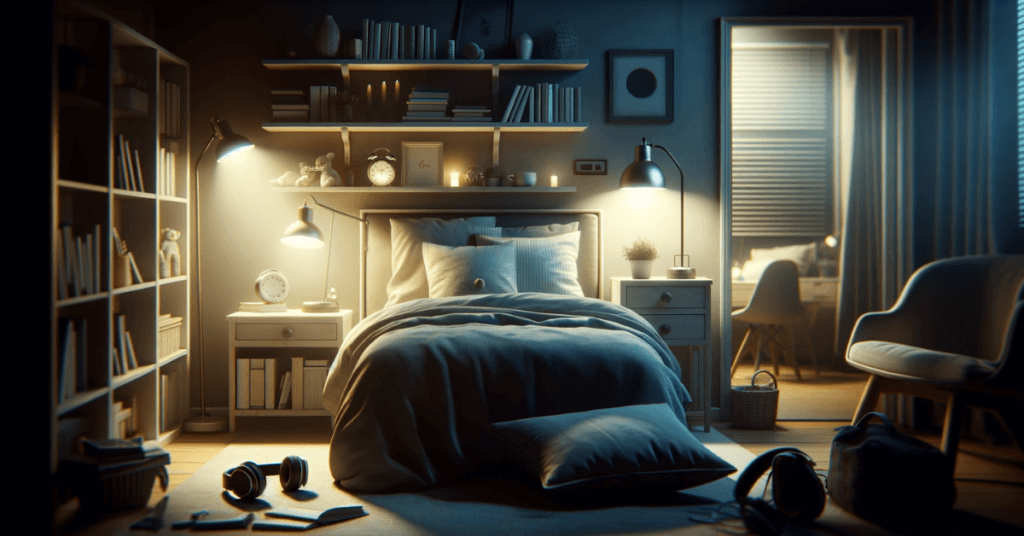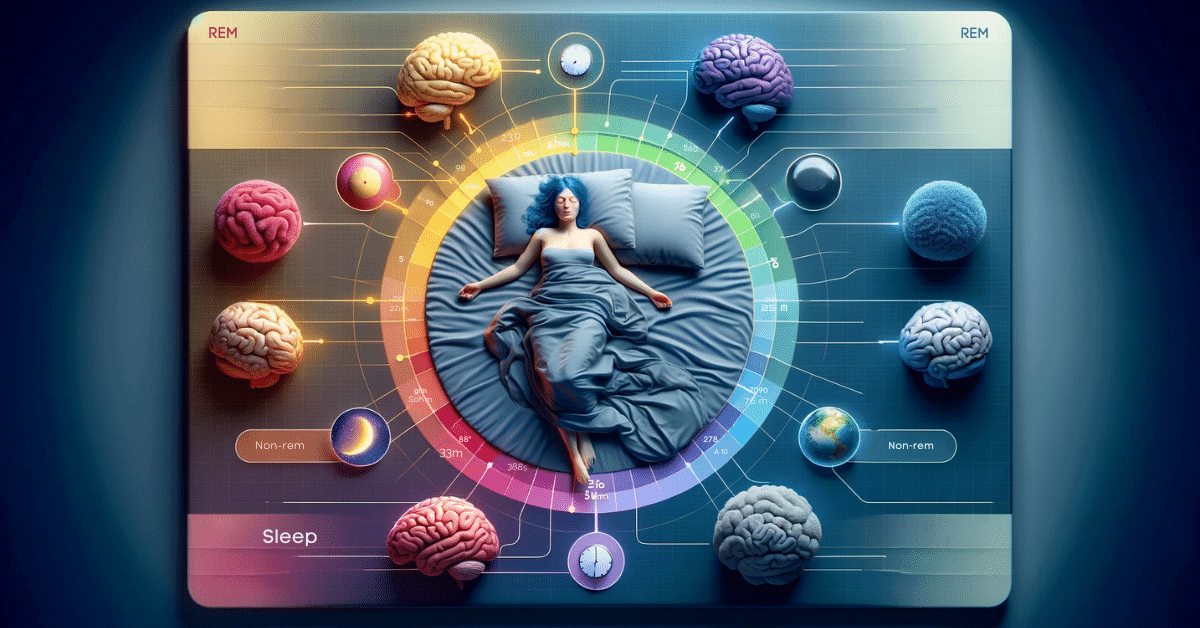Hey there, fellow dreamers! Ever feel like the quest for the perfect night’s sleep is like trying to solve a Rubik’s Cube in the dark? Well, you’re not alone! Today, we’re embarking on a nocturnal adventure to decode the mystery of sleep stages 12. From the tiny tots to the wise and weathered, we’ll explore how our sleep evolves and how to get those golden zzz’s at every age. Ready to become a sleep cycle sleuth? Let’s dive in!
Unraveling the Sleep Cycle: REM and Non-REM Explained
Key Takeaways:
- Understanding sleep cycles, both REM and non-REM, is crucial for good sleep.
- Each age group has unique sleep cycle characteristics and needs.
- Simple, practical tips can optimize your sleep, no matter your age.
- Adapting to changes in sleep patterns is key for long-term health and happiness.
In the mysterious world of slumber, sleep cycles are the unsung heroes, working tirelessly every night. Picture this: each cycle is like a mini-journey, starting with a descent into non-REM sleep, where our bodies repair and rejuvenate. This stage is all about slowing down – the heart rate drops, muscles relax, and brain waves start to chill out. Then, as we switch to REM sleep, the magic happens. This is where dreams come alive, and the brain gets busy processing emotions and memories. It’s a bit like a nightly brain workout!
The normal sleep stages for an adult involve:
- Awake: Brief periods of wakefulness can occur throughout the night, often unnoticed.
- Stage 1 (N1) – Light Sleep: This is the transition phase from wakefulness to sleep, lasting several minutes. The sleeper experiences a slowdown in both their heartbeat and breathing, and their muscles relax with occasional twitches.
- Stage 2 (N2) – Light Sleep: This stage lasts for about 20-25 minutes. Brain waves slow down, with occasional bursts of rapid waves called sleep spindles. Body temperature drops and heart rate slows further.
- Stage 3 (N3) – Deep Sleep: This stage is crucial for feeling refreshed in the morning. It typically begins about 35-45 minutes after falling asleep. It’s a period of deep, restorative sleep, where the body repairs muscles and tissues, stimulates growth and development, boosts immune function, and builds up energy for the next day.
- REM (Rapid Eye Movement) Sleep: This stage occurs about 90 minutes after falling asleep. Eyes move rapidly behind closed lids, breathing becomes faster and irregular, and heart rate and blood pressure increase to near waking levels. Most dreaming occurs during REM sleep, and the arm and leg muscles become temporarily paralyzed, which prevents people from acting out their dreams.
An adult typically cycles through these stages 4-6 times during a night’s sleep, with each cycle lasting about 90-110 minutes. As the night progresses, the duration of REM sleep increases while deep sleep decreases.
Sleep Cycle Calculator
The Sleep Cycle Calculator for adults below is designed to help optimize your sleep quality by calculating the ideal times for you to go to bed based on when you need to wake up. Here’s an explanation of how it works:
- Input Wake-Up Time: You start by entering the time you need to wake up.
- Sleep Cycles: The calculator operates on the principle that sleep is composed of multiple 90-minute cycles. Each cycle involves various stages of sleep, including deep sleep and REM sleep, which are crucial for feeling rested.
- Calculating Bedtimes: Based on the wake-up time you input, the calculator works backward in 90-minute increments, representing each sleep cycle. It recommends times that would allow for completing 5-6 sleep cycles, as this is considered optimal for most adults.
- Falling Asleep Time: The calculator also factors in an average of 15 minutes that it takes a person to fall asleep after getting into bed. This is subtracted from each calculated bedtime to give a more accurate timing.
Sleep Cycle Calculator
Sleep Cycles in Infancy and Early Childhood
Babies and sleep – it’s a whole new world of discovery. Did you know that newborns can sleep up to 18 hours a day? That’s a lot of snoozing! But it’s not just about quantity; it’s the quality and pattern of sleep that’s fascinating. In the early months, babies spend a lot of time in REM sleep, which is crucial for their rapid brain development. It’s like their brains are on a super-fast learning curve, and sleep is their secret weapon. But as any parent will tell you, getting babies into a sleep routine can feel like navigating a maze blindfolded.

The key is consistency – a warm bath, a soothing lullaby, and a cozy, dim-lit environment can work wonders. And here’s a pro tip: watch out for those sleep cues, like rubbing eyes or yawning. They’re the baby’s way of saying, “Hey, I’m ready for dreamland!” But remember, every baby is unique, and what works for one might not work for another. It’s all about tuning into your little one’s rhythm and going with the flow.
| Life Stage | Healthy Sleep Habits |
|---|---|
| Infancy | Regular nap times, soothing bedtime routine, calm sleep environment |
| Childhood | Set a regular bedtime, limit screen time, create a quiet sleep space |
| Adolescence | Consistent sleep schedule, reduce caffeine, promote cool sleep setting |
| Adulthood | Establish a sleep routine, manage stress, disconnect from screens |
| Elderly | Maintain a regular sleep schedule, ensure daytime activity, a comfortable sleep environment |
Adolescence to Adulthood: Sleep Cycles in Transition
Welcome to the rollercoaster ride of teenage sleep! It’s a time of big changes, not just in life but in sleep too. As teens hit puberty, their internal clocks do a flip, pushing them towards late nights and late mornings. It’s like their bodies are wired to rebel against early bedtimes. And it’s not just about being a night owl; this shift can affect mood, focus, and overall health. But here’s the challenge: aligning this new sleep rhythm with school and social life. For the night-owl teens, creating a relaxing bedtime routine is key.

Think less screen time and more chill time. Maybe a bit of light reading or some soothing music. And for the parents? Patience is your best friend. Then, as we march into adulthood, the sleep puzzle gets even trickier. Juggling work, family, and a gazillion other responsibilities can turn our nights into a game of sleep Tetris. But fear not, there’s hope. Setting a regular sleep schedule and creating a calming pre-sleep routine can bring back those peaceful zzz’s. Think of it as setting the stage for a night at the sleep theater – the better the setup, the better the performance.
| Age Group | Average Sleep Needs | Key Notes |
|---|---|---|
| Newborns (0-3 months) | 14-17 hours | Predominantly REM sleep for brain development |
| Infants (4-11 months) | 12-15 hours | Gradual regulation of sleep, important for growth |
| Toddlers (1-2 years) | 11-14 hours | Naps decrease, night sleep becomes more consistent |
| Preschoolers (3-5 years) | 10-13 hours | Essential for cognitive and physical development |
| School-age Children (6-13 years) | 9-11 hours | Important for learning, growth, and overall development |
| Teenagers (14-17 years) | 8-10 hours | Adjustments needed for biological clock changes |
| Adults (18-64 years) | 7-9 hours | Quality affected by lifestyle, stress, and health |
| Elderly (65+ years) | 7-8 hours | Lighter, more fragmented sleep, adjustments needed |
Mastering Sleep in Midlife and Beyond
As we step into the world of adulting, our sleep often takes a backseat. But it shouldn’t be this way. Sleep in adulthood is like the anchor that keeps us steady amidst the storms of life. It’s when we juggle jobs, family, and all the curveballs life throws at us, and yet, we need to find time to recharge our batteries. Here’s the secret: it’s all about creating a sleep sanctuary. A comfy mattress, a dark, cool room, and maybe some gentle background sounds – these are the ingredients for a sleep haven.

And let’s talk about routines – they’re not just for kids. A pre-sleep ritual, be it a warm bath or some light yoga, can signal to your body that it’s time to wind down. But there’s more to it. Sleep in midlife is also about dealing with the sneaky sleep snatchers – stress, health changes, and yes, even the late-night snacks. It’s about understanding that good sleep is a 24/7 commitment, not just an afterthought. And for those struggling with sleep issues, seeking help is not just important, it’s essential. Remember, good sleep is the foundation of good health, and it’s never too late to start building it.
| Age Group | Common Sleep Disorders |
|---|---|
| Infants and Toddlers | Sleep regression, Night terrors |
| Children and Teenagers | Insomnia, Sleepwalking |
| Adults | Sleep apnea, Insomnia |
| Seniors | Insomnia, Sleep phase syndrome |
Sleep Cycles in the Elderly: Adapting to Age-Related Changes
As we gracefully glide into our golden years, our sleep takes on a new rhythm. It’s a time when deep sleep becomes more elusive, and we might find ourselves waking up at the crack of dawn. But here’s the thing: quality sleep is just as important now as it was in our youth. The key is understanding and adapting to these changes. Creating a peaceful sleep environment, maintaining a regular sleep-wake schedule, and addressing any underlying sleep disorders are the golden rules.

And let’s not forget the power of a daytime nap – short and sweet is the way to go. For seniors, good sleep is about embracing the changes and finding new ways to enjoy restful nights. It’s about respecting our bodies and giving them the rest they deserve. So, let’s celebrate these years with the gift of good sleep, making every night a journey to dreamland.
Conclusion
And that’s a wrap on our sleep cycle saga! From the cradle to the rocking chair, understanding and adapting our sleep rituals is vital for health and happiness. Each stage of life brings new sleep adventures, and with a little know-how, we can all enjoy the sweet embrace of dreamland. So, fluff up those pillows, find your sleep rhythm, and let’s catch those zzz’s in style. Here’s to dreaming big at any age!
Want to learn more about sleep management? Check out our main post on stress and sleep.
Frequently Asked Questions
What is a Normal Sleep Pattern?
A normal sleep pattern typically involves 7-9 hours of sleep per night for adults. This pattern includes cycles of both REM (Rapid Eye Movement) and Non-REM sleep, occurring in 90-minute intervals. Good sleep hygiene, like maintaining a consistent sleep schedule and creating a relaxing bedtime routine, helps in achieving this pattern. It’s important to note that ‘normal’ can vary based on individual needs and lifestyles.
What Sleep Pattern is Healthiest?
The healthiest sleep pattern is one that allows you to wake up feeling refreshed and alert. This usually means getting enough hours of quality sleep, typically 7-9 hours for adults. It should include a balance of both REM and non-REM sleep cycles. Consistency is also key – going to bed and waking up at the same time every day, even on weekends, helps regulate your body’s internal clock.
What is the Best Sleeping Pattern?
The best sleeping pattern is one that aligns with your body’s natural circadian rhythms and meets your personal sleep needs. For most adults, this means 7-9 hours of uninterrupted sleep, with a regular bedtime and wake-up time. Ensuring a sleep-friendly environment – quiet, dark, and cool – and limiting screen time before bed are also crucial for a restorative sleep pattern.
What is the Typical Pattern of Sleep?
The typical pattern of sleep involves cycling through four stages: three stages of non-REM sleep followed by a REM sleep stage. These cycles repeat approximately every 90 minutes. Non-REM sleep includes light sleep (stages 1 and 2) and deep sleep (stage 3), which is crucial for physical recovery. REM sleep, where dreaming occurs, is important for cognitive functions like memory and learning.
How Many Hours Is a Sleep Cycle?
A typical sleep cycle lasts about 90 to 120 minutes. During this time, a person progresses through the stages of non-REM sleep and into REM sleep. Adults typically have 4-5 sleep cycles per night. The duration of each stage within the cycle can vary, with REM sleep periods lengthening in the second half of the night. Understanding this cycle can help in optimizing sleep quality.




